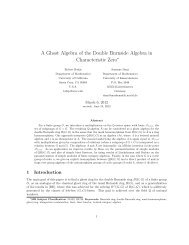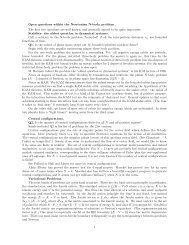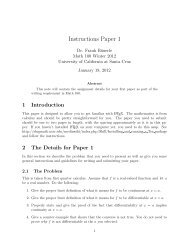Lecture Notes 2 A
Lecture Notes 2 A
Lecture Notes 2 A
- No tags were found...
You also want an ePaper? Increase the reach of your titles
YUMPU automatically turns print PDFs into web optimized ePapers that Google loves.
LECTURE 2. (TEXED): IN CLASS: PROBABLY LECTURE 3.MANIFOLDS 1. FALL 2006. TANGENT VECTORS.Overview: Tangent vectors, spaces and bundles. First: to an embedded manifoldof Euclidean space. Then to one defined by the vanishing of a submersion (theImplicit FT). Then abstract, via curves.Vector structure on the tangent space.Vector bundle structure.Reading: Milnor, p. 2,3. Lee, ch. 3.1. The tangent space to an embedded submanifold.We begin with the sphere, S 2 ⊂ R 3 . Then the tangent space to ω ∈ S 2 consistsof the plane orthogonal to ω and passing through ω. Why? What is the definitionof tangent space?We will begin with the following definition for an embedded manifold M n of aEuclidean space E. Let p ∈ M. If c is a smooth curve in M passing through m attime t = 0, then we can take its derivative at t = 0: dc/dt| t=0 ∈ E. We assembleall of these together to form the tangent space to M at p. This space is denotedT p M.Definition 1.1.T p M = {dc/dt|t = 0 : c a smooth curve in M with c(0) = p}This set is known as the tangent space to M at mProposition 1.2. If f : U ⊂ R n is any parameterization of M covering a nbhd ofm then T p M = im(df(q)) where q = f −1 (m).Proof. In the definition, the domain of c does not matter as long as it contains0 which is mapped to p under c. So we can assume that the curves c lie in f(U).Then any such curve has the form f ◦ γ(t) where γ(t) is an arbitrary smooth curvethrough q at t = 0. We then have dc/dt| t=0 = df ◦ v where v = dγ/dt| t=0 . Byvarying γ we can make any vector v in R n . For example, just set γ(t) = q + tv. Sothe collection of dc/dt(0)’s coincides with im(df q ). QEDThis proposition shows that the tangent spaces are endowed with a linear structure,being the image of a linear space under a linear map. But the tangent space hasno canonical basis, because there are no canonical parameterization f : R n − → M.Remark: affine version For the purposes of visualization it is often best, withembedded submanifolds, to translate the tangent space as defined above so as toobtain a plane passing through p. We will call this the affine tangent space, andwrite it as: T p M affine := p + T p M. This is the definition that best fits with firstquarter calculus. For example, a function y = f(x), as thought of in calculus, can beturned into an embedded 1-manifold of the plane by using its graph: x ↦→ (x, f(x)).1
LECTURE 2. (TEXED): IN CLASS: PROBABLY LECTURE 3. MANIFOLDS 1. FALL 2006. TANGENT VECTORS.3This definition depended on a chart. For it to be a good definition, what we call“intrinsic” it must be independent of the choice of chart.Lemma 2.2. Let M be a smooth manifold, p ∈ M and φ a chart whose domaincovers p. Then the equivalence relation ∼ φ on curves passing through p does notdepend on the choice of chart: c 1 ∼ φ c 2 ⇐⇒ c 1 ∼ ψ c 2 , for ψ another chart whosedomain covers pProof. Use, as always, the transition maps ψ −1 ◦ φ.Definition 2.3. A tangent vector at p is an equivalence class for a smooth curvec passing through p. We write: v = c ′ (0), or v = [c] or v = [c] p for the resultingequivalence class of curves. The tangent space T p M at p is the set of theseequivalence classes c ′ (0).Proposition 2.4. The tangent space at p has a natural linear structure.Proof. Let v, w ∈ T p M. To add them, choose any chart. Let c 1 , c 2 be the curveswhich represent them, and write V = dφ(v), W = dφ(w) to mean the derivative ofφ◦c 1 , φ◦c 2 at t = 0. Choose any smooth curve in R n tangent to V +W , for exampleγ(t) = x + t(V + W ) where x = φ(p). We represent v + w as the equivalence classφ −1 ◦ γ ′ (0). To see that this definition of vector addition is independent of chart,note that if ψ were another chart, then the derivatives of ψ ◦ c 1 , ψ ◦ c 2 at t = 0would be given by L(V ) + L(W ) = L(V + W ) where L = d(ψ ◦ φ −1 ) evaluated atthe point corresponding to p.For scalar multipication, note that if v is represented by c(t) in R n , then c(λt)will represent λv. Now this carries over to the manifold, and is chart-independent.Proposition 2.5. ?? If E is a f.d. real vector space, and p ∈ E then we have acanonical isomorphism T p E ∼ = E.Proof. A curve c(t) through p is equivalent to a parameterized line p + tv wherev = c ′ (0). This correspondence sets up a bijection between the equivalence classesof curves and the elements of v. QEDTerminology This important isomorphism is called ‘translation’ or “parallelism”or “parallel translation”. Algebraically it is implemented by adding p tov ∈ E.Differential If F : M → X is a smooth map between manifolds we define itsdifferential at p.Definition 2.6. The differential of F at p, variously denoted as dF (p) or F ∗p isthe map T p M → T F (p) M which takes the vector v described by the curve c to thevector dF (p)(v) described by the curve F ◦ c.Proposition 2.7. The differential dF (p) is a linear map T p M → T F (p) M.Proof. Work using charts, φ, ψ. In the coordinate picture F becomes the(nonlinear) map ψ ◦ F ◦ φ −1 : R n → R k . Its differential, as defined via curves, isthe usual differential which is linear.Important example. If φ = (x 1 , . . . , x n ) : M− → R n is a chart, then itsdifferential dφ p : T m M → T φ(p) R n = R n is a linear isomorphism for each p in the
LECTURE 2. (TEXED): IN CLASS: PROBABLY LECTURE 3. MANIFOLDS 1. FALL 2006. TANGENT VECTORS.5More terminology. The fibers of E are the sets π −1 (m) := E m . Becausethe g αβ (x) are linear functions, each fiber has the structure of a vector space,independent of choice of local trivialization. So it makes sense to scalar multiplyan element of E, or to add to elements which lie in the same fiber. We cannotconsistently add elements lying in different fibers. Each E m has its zero vector O mand the map m ↦→ O m is called the zero section. It is a continuous map s : M → Esatisfying π ◦ s = s. More generally, any map M → E satisfying π ◦ s is called asection of E.Definition 3.1. A smooth vector bundle π : E → M is a vector bundle over asmooth manifold, which is a smooth manifold in its own right, and is such that thelocal trivializations and clutching functions are all smooth.Examples Big example. The tangent bundle of a manifold.Other examples. If M ⊂ R N is an embedded submanifold, then we can defineits normal bundle νM by setting ν m (M) = (T m M) ⊥ where we use the standardinner product to take perpindiculars.Examples. Tensor product of vector bundles. Direct sum of vector bundles.Duals to vector bundles. If E, F → M are (smooth) vector bundles, then so areE ⊗ F, E ⊕ F, E ∗ and Hom(E, F ). Their fibers are E m ⊗ F m , E m ⊕ F m , Em ∗ andHom(E m , F m ). Their clutching functions are g αβ ⊗ h αβ , g αβ ⊕ h αβ , gαβ ∗ , ... . ... .The Trivial bundle Is the bundle M × E → M.Exercise. For M ⊂ R N an embedded submanifold, prove that ν(M) ⊕ T M =M × R N is the trivial bundle.Vector bundle maps. A v.b. map G : E → F between two vector bundles overthe same space M is a continous map which is linear on each fiber. If E → M,F → N and g : M → N then a vector bundle map over f is a map E → F suchthat G(E m ) ⊂ F g(m) and G is linear on each fiber.Similarly, we define smooth vector bundle maps if E, F are smooth vector bundles.Proposition 3.2. If g : M → N is smooth, then dg : T M → T N is a smoothvector bundle map covering g.
















